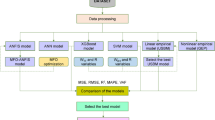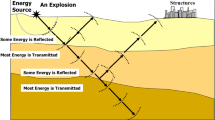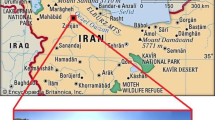Abstract
An ensemble technique namely gradient boosted tree (GBTs) and several optimized neural network models were hybridized to predict peak particle velocity (PPV) caused by quarry blasting. The GBT was employed for choosing the most important input parameters on PPV results. Therefore, this model selected five input variables, comprising maximum charge per delay, distance, powder factor, and sub-drilling, and RQD. Once the input assortment was performed, five neural network models, including a typical artificial neural network (ANN) and ANNs with weight optimization (forward, backward, particle swarm optimization, PSO, and evolutionary), were implemented utilizing the inputs picked by the GBT. These models were assessed by several performance criteria, including the “correlation coefficient”, “root mean square error”, “variance accounted for”, “a20-index”, and a simple ranking system, as well as optimized weights. The results of hybridization showed that ANN-PSO model outperformed other models in terms of system error and accuracy. Altogether, this study's findings implied that consolidating the ensemble machine learning technique and optimized ANN models, particularly PSO could result in perfect and straightforward to understand predictions of PPV caused by quarry blasting.










Similar content being viewed by others
References
Adhikari, R., & Agrawal, R. (2011). Effectiveness of PSO based neural network for seasonal time series forecasting. IICAI, 3, 231–244.
Armaghani, D. J., Hajihassani, M., Mohamad, E. T., Marto, A., & Noorani, S. A. (2014). Blasting-induced flyrock and ground vibration prediction through an expert artificial neural network based on particle swarm optimization. Arabian Journal of Geosciences, 7(12), 5383–5396.
Armaghani, D. J., Mirzaei, F., Shariati, M., Trung, N. T., Shariati, M., & Trnavac, D. (2020). Hybrid ann-based techniques in predicting cohesion of sandy-soil combined with fiber. Geomechanics and Engineering, 20(3), 191–205. https://doi.org/10.12989/gae.2020.20.3.191
Armaghani, D. J., Mohamad, E. T., Narayanasamy, M. S., Narita, N., & Yagiz, S. (2017). Development of hybrid intelligent models for predicting TBM penetration rate in hard rock condition. Tunnelling and Underground Space Technology, 63, 29–43. https://doi.org/10.1016/j.tust.2016.12.009
Arthur, C. K., Temeng, V. A., & Ziggah, Y. Y. (2020). Novel approach to predicting blast-induced ground vibration using Gaussian process regression. Engineering with Computers, 36(1), 29. https://doi.org/10.1007/s00366-018-0686-3
Asteris, P. G., Mamou, A., Hajihassani, M., Hasanipanah, M., Koopialipoor, M., Le, T. T., … Armaghani, D. J. (2021). Soft computing based closed form equations correlating L and N-type Schmidt hammer rebound numbers of rocks. Transportation Geotechnics, 29, 100588.
Azizi, A. (2018). Computer-based analysis of the stochastic stability of mechanical structures driven by white and colored noise. Sustainability, 10(10), 3419.
Azizi, A., Entessari, F., Osgouie, K. G., & Rashnoodi, A. R. (2014). Introducing neural networks as a computational intelligent technique. In Applied mechanics and materials (Vol. 464, pp. 369–374). Trans Tech Publications Ltd.
Bui, X.-N., Choi, Y., Atrushkevich, V., Nguyen, H., Tran, Q.-H., Long, N. Q., & Hoang, H.-T. (2020). Prediction of blast-induced ground vibration intensity in open-pit mines using unmanned aerial vehicle and a novel intelligence system. Natural Resources Research, 29(2), 771–790.
Davies, B., Farmer, I. W., & Attewell, P. B. (1964). Ground vibration from shallow sub-surface blasts. Engineer, 217(5644).
Dindarloo, S. R. (2015). Prediction of blast-induced ground vibrations via genetic programming. International Journal of Mining Science and Technology, 25(6), 1011. https://doi.org/10.1016/j.ijmst.2015.09.020
Dowding, C. H. (1985). Blast vibration monitoring and control. Prentice Hall.
Duvall, W. I., & Petkof, B. (1959). Spherical propagation of explosion-generated strain pulses in rock. US Department of the Interior, Bureau of Mines.
Duvall, W. I., & Fogelson, D. E. (1962). Review of criteria for estimating damage to residences from blasting vibrations. US Department of the Interior, Bureau of Mines.
Fişne, A., Kuzu, C., & Hüdaverdi, T. (2011). Prediction of environmental impacts of quarry blasting operation using fuzzy logic. Environmental Monitoring and Assessment, 174(1–4), 461–470.
Friedman, J. H. (2001). Greedy function approximation: a gradient boosting machine. Annals of Statistics, 1189–1232.
Ghafoorpoor Yazdi, P., Azizi, A., & Hashemipour, M. (2019). A hybrid methodology for validation of optimization solutions effects on manufacturing sustainability with time study and simulation approach for SMEs. Sustainability, 11(5), 1454.
Ghasemi, E., Ataei, M., & Hashemolhosseini, H. (2013). Development of a fuzzy model for predicting ground vibration caused by rock blasting in surface mining. Journal of Vibration and Control, 19(5), 755–770.
Ghosh, A., & Daemen, J. J. K. (1983). A simple new blast vibration predictor (based on wave propagation laws). The 24th US Symposium on Rock Mechanics (USRMS). American Rock Mechanics Association.
Hajihassani, M., Jahed Armaghani, D., & Kalatehjari, R. (2018). Applications of particle swarm optimization in geotechnical engineering: A comprehensive review. Geotechnical and Geological Engineering, 36(2), 705–722. https://doi.org/10.1007/s10706-017-0356-z
Hajihassani, M., Jahed Armaghani, D., Marto, A., & Tonnizam Mohamad, E. (2014a). Ground vibration prediction in quarry blasting through an artificial neural network optimized by imperialist competitive algorithm. Bulletin of Engineering Geology and the Environment, 74, 873–886. https://doi.org/10.1007/s10064-014-0657-x
Hajihassani, M., Jahed Armaghani, D., Sohaei, H., Tonnizam Mohamad, E., & Marto, A. (2014b). Prediction of airblast-overpressure induced by blasting using a hybrid artificial neural network and particle swarm optimization. Applied Acoustics, 80, 57–67. https://doi.org/10.1016/j.apacoust.2014.01.005
Hajihassani, M., Jahed Armaghani, D., Monjezi, M., Mohamad, E. T., & Marto, A. (2015). Blast-induced air and ground vibration prediction: A particle swarm optimization-based artificial neural network approach. Environmental Earth Sciences, 74(4), 2799–2817. https://doi.org/10.1007/s12665-015-4274-1
Han, H., Armaghani, D. J., Tarinejad, R., Zhou, J., & Tahir, M. M. (2020). Random forest and Bayesian network techniques for probabilistic prediction of Flyrock induced by blasting in quarry sites. Natural Resources Research. https://doi.org/10.1007/s11053-019-09611-4
Hasanipanah, M., Shahnazar, A., Arab, H., Golzar, S. B., & Amiri, M. (2017). Developing a new hybrid-AI model to predict blast-induced backbreak. Engineering with Computers, 33(3), 349. https://doi.org/10.1007/s00366-016-0477-7
Huang, J., Duan, T., Zhang, Y., Liu, J., Zhang, J., & Lei, Y. (2020). Predicting the permeability of pervious concrete based on the beetle antennae search algorithm and random forest model. Advances in Civil Engineering, 2020. Article ID 8863181
Huang, J., Kumar, G. S., & Sun, Y. (2021b). Evaluation of workability and mechanical properties of asphalt binder and mixture modified with waste toner. Construction and Building Materials, 276, 122230. https://doi.org/10.1016/j.conbuildmat.2020.122230
Huang, J., Shiva Kumar, G., Ren, J., Sun, Y., Li, Y., & Wang, C. (2021c). Towards the potential usage of eggshell powder as bio-modifier for asphalt binder and mixture: workability and mechanical properties. International Journal of Pavement Engineering. https://doi.org/10.1080/10298436.2021.1905809
Huang, J., Sun, Y., & Zhang, J. (2021a). Reduction of computational error by optimizing SVR kernel coefficients to simulate concrete compressive strength through the use of a human learning optimization algorithm. Engineering with Computers. https://doi.org/10.1007/s00366-021-01305-x
Huang, J., & Wang, Q. A. (2021). Influence of crumb rubber particle sizes on rutting, low temperature cracking, fracture, and bond strength properties of asphalt binder. Materials and Structures, 54(2). https://doi.org/10.1617/s11527-021-01647-4
Huang, J., Zhang, J., Ren, J., & Chen, H. (2021e). Anti-rutting performance of the damping asphalt mixtures (DAMs) made with a high content of asphalt rubber (AR). Construction and Building Materials, 271, 121878.
Huang, J., Zhang, Y., Sun, Y., Ren, J., Zhao, Z., & Zhang, J. (2021d). Evaluation of pore size distribution and permeability reduction behavior in pervious concrete. Construction and Building Materials, 290, 123228. https://doi.org/10.1016/j.conbuildmat.2021.123228
Hudaverdi, T. (2012). Application of multivariate analysis for prediction of blast-induced ground vibrations. Soil Dynamics and Earthquake Engineering, 43, 300–308.
Iphar, M., Yavuz, M., & Ak, H. (2008). Prediction of ground vibrations resulting from the blasting operations in an open-pit mine by adaptive neuro-fuzzy inference system. Environmental Geology, 56(1), 97–107.
Jahed Armaghani, D., Hajihassani, M., Monjezi, M., Mohamad, E. T., Marto, A., & Moghaddam, M. R. (2015). Application of two intelligent systems in predicting environmental impacts of quarry blasting. Arabian Journal of Geosciences, 8(11), 9647. https://doi.org/10.1007/s12517-015-1908-2
Kamavisdar, P., Saluja, S., & Agrawal, S. (2013). A survey on image classification approaches and techniques. International Journal of Advanced Research in Computer and Communication Engineering, 2(1), 1005–1009.
Kardani, N., Bardhan, A., Samui, P., Nazem, M., Zhou, A., & Armaghani, D. J. (2021). A novel technique based on the improved firefly algorithm coupled with extreme learning machine (ELM-IFF) for predicting the thermal conductivity of soil. Engineering with Computers. https://doi.org/10.1007/s00366-021-01329-3
Kardani, N., Zhou, A., Nazem, M., & Shen, S.-L. (2020). Estimation of bearing capacity of piles in cohesionless soil using optimised machine learning approaches. Geotechnical and Geological Engineering, 38(2), 2271–2291.
Khandelwal, M., Marto, A., Fatemi, S. A., Ghoroqi, M., Armaghani, D. J., Singh, T. N., & Tabrizi, O. (2017). Implementing an ANN model optimized by genetic algorithm for estimating cohesion of limestone samples. Engineering with Computers, 34(2), 307–317.
Khandelwal, M., & Singh, T. N. (2005). Prediction of blast induced air overpressure in opencast mine. Noise & Vibration Worldwide, 36(2), 7–16.
Khandelwal, M., & Singh, T. N. (2006). Prediction of blast induced ground vibrations and frequency in opencast mine: A neural network approach. Journal of Sound and Vibration, 289(4–5), 711–725.
Khandelwal, M., & Singh, T. N. (2009). Prediction of blast-induced ground vibration using artificial neural network. International Journal of Rock Mechanics and Mining Sciences, 46(7), 1214–1222.
Koopialipoor, M., Jahed Armaghani, D., Haghighi, M., & Ghaleini, E. N. (2019). A neuro-genetic predictive model to approximate overbreak induced by drilling and blasting operation in tunnels. Bulletin of Engineering Geology and the Environment, 78(2), 981–990. https://doi.org/10.1007/s10064-017-1116-2
Langefors, U., & Kihlström, B. (1963). The modern technique of rock blasting. Wiley.
Liu, J., Savenije, H. H. G., & Xu, J. (2003). Forecast of water demand in Weinan City in China using WDF-ANN model. Physics and Chemistry of the Earth, Parts A/b/c, 28(4–5), 219–224.
Momeni, E., Yarivand, A., Dowlatshahi, M. B., & Armaghani, D. J. (2020). An Efficient Optimal Neural Network Based on Gravitational Search Algorithm in Predicting the Deformation of Geogrid-Reinforced Soil Structures. Transportation Geotechnics, 100446.
Monjezi, M., Baghestani, M., Shirani Faradonbeh, R., Pourghasemi Saghand, M., & Jahed Armaghani, D. (2016). Modification and prediction of blast-induced ground vibrations based on both empirical and computational techniques. Engineering with Computers, 32(4), 717. https://doi.org/10.1007/s00366-016-0448-z
Monjezi, M., Ghafurikalajahi, M., & Bahrami, A. (2011). Prediction of blast-induced ground vibration using artificial neural networks. Tunnelling and Underground Space Technology, 26(1), 46–50. https://doi.org/10.1016/j.tust.2010.05.002
Monjezi, M., & Dehghani, H. (2008). Evaluation of effect of blasting pattern parameters on back break using neural networks. International Journal of Rock Mechanics and Mining Sciences, 45(8), 1446–1453.
Monjezi, M., Hasanipanah, M., & Khandelwal, M. (2013). Evaluation and prediction of blast-induced ground vibration at Shur River Dam, Iran, by artificial neural network. Neural Computing and Applications, 22(7–8), 1637–1643.
New, B. M. (1986). Ground vibration caused by civil engineering works.
Nguyen, H., Drebenstedt, C., Bui, X.-N., & Bui, D. T. (2019). Prediction of blast-induced ground vibration in an open-pit mine by a novel hybrid model based on clustering and artificial neural network. Natural Resources Research. https://doi.org/10.1007/s11053-019-09470-z
Nguyen, H., Bui, X. N., Bui, H. B., & Mai, N. L. (2020). A comparative study of artificial neural networks in predicting blast-induced air-blast overpressure at Deo Nai open-pit coal mine, Vietnam. Neural Computing and Applications, 32(8), 3939–3955.
Ozer, U., Kahriman, A., Aksoy, M., Adiguzel, D., & Karadogan, A. (2008). The analysis of ground vibrations induced by bench blasting at Akyol quarry and practical blasting charts. Environmental Geology, 54(4), 737–743.
Poli, R., Kennedy, J., & Blackwell, T. (2007). Particle swarm optimization. Swarm Intelligence, 1(1), 33–57.
Roy, P. (1993). Putting ground vibration predictions into practice. Colliery Guardian, 241(2), 63–67.
Shang, Y., Nguyen, H., Bui, X.-N., Tran, Q.-H., & Moayedi, H. (2019). A novel artificial intelligence approach to predict blast-induced ground vibration in open-pit mines based on the firefly algorithm and artificial neural network. Natural Resources Research, 29, 723–737.
Shi, Y., & Eberhart, R. (1998). A modified particle swarm optimizer. In 1998. IEEE World Congress on Computational Intelligence., The 1998 IEEE International Conference On, 69–73. IEEE.
Shirani Faradonbeh, R., Jahed Armaghani, D., Abd Majid, M. Z., Tahir, M., Ramesh Murlidhar, B., Monjezi, M., & Wong, H. M. (2016). Prediction of ground vibration due to quarry blasting based on gene expression programming: a new model for peak particle velocity prediction. International Journal of Environmental Science and Technology, 13(6), 1453. https://doi.org/10.1007/s13762-016-0979-2
Singh, T. N., & Singh, V. (2005). An intelligent approach to prediction and control ground vibration in mines. Geotechnical & Geological Engineering, 23(3), 249–262.
Siskind, D. (2005). Vibrations from blasting. Society of Explosives Engineers.
Siskind, D. E., Stachura, V. J., Stagg, M. S., & Kopp, J. W. (1980). Structure response and damage produced by airblast from surface mining. Citeseer.
Standard, I. (1973). Criteria for safety and design of structures subjected to under ground blast. ISI., IS-6922.
Tonnizam Mohamad, E., Jahed Armaghani, D., Hasanipanah, M., Murlidhar, B. R., & Alel, M. N. A. (2016). Estimation of air-overpressure produced by blasting operation through a neuro-genetic technique. Environmental Earth Sciences, 75(2), 1–15. https://doi.org/10.1007/s12665-015-4983-5
Yang, H., Rad, H. N., Hasanipanah, M., Amnieh, H. B., & Nekouie, A. (2020a). Prediction of vibration velocity generated in mine blasting using support vector regression improved by optimization algorithms. Natural Resources Research, 29(2), 807–830.
Yang, H., Wang, Z., & Song, K. (2020b). A new hybrid grey wolf optimizer-feature weighted-multiple kernel-support vector regression technique to predict TBM performance. Engineering with Computers. https://doi.org/10.1007/s00366-020-01217-2
Zhang, H., Zhou, J., Armaghani, D. J., Tahir, M. M., Pham, B. T., & Huynh, V. V. (2020). A combination of feature selection and random forest techniques to solve a problem related to blast-induced ground vibration. Applied Sciences, 10(3), 869.
Zhou, J., Asteris, P. G., Armaghani, D. J., & Pham, B. T. (2020a). Prediction of ground vibration induced by blasting operations through the use of the Bayesian Network and random forest models. Soil Dynamics and Earthquake Engineering, 139(August), 106390. https://doi.org/10.1016/j.soildyn.2020.106390
Zhou, J., Li, X., & Shi, X. (2012). Long-term prediction model of rockburst in underground openings using heuristic algorithms and support vector machines. Safety Science, 50(4), 629–644.
Zhou, X., Armaghani, D. J., Ye, J., Khari, M., & Motahari, M. R. (2020b). Hybridization of Parametric and Non-parametric Techniques to Predict Air Over-pressure Induced by Quarry Blasting. Natural Resources Research. https://doi.org/10.1007/s11053-020-09714-3
Zorlu, K., Gokceoglu, C., Ocakoglu, F., Nefeslioglu, H. A., & Acikalin, S. (2008). Prediction of uniaxial compressive strength of sandstones using petrography-based models. Engineering Geology, 96(3), 141–158.
Acknowledgments
We acknowledge the financial support from the National Natural Science Foundation of China (51974043, 51774058). In addition, the first corresponding author thanks the Science and Technology Planning Project of Chongqing Education Commission (KJQN201804305) (JG-KJ-2019-006).
Author information
Authors and Affiliations
Corresponding authors
Rights and permissions
About this article
Cite this article
Peng, K., Zeng, J., Armaghani, D.J. et al. A Novel Combination of Gradient Boosted Tree and Optimized ANN Models for Forecasting Ground Vibration Due to Quarry Blasting. Nat Resour Res 30, 4657–4671 (2021). https://doi.org/10.1007/s11053-021-09899-1
Received:
Accepted:
Published:
Issue Date:
DOI: https://doi.org/10.1007/s11053-021-09899-1




